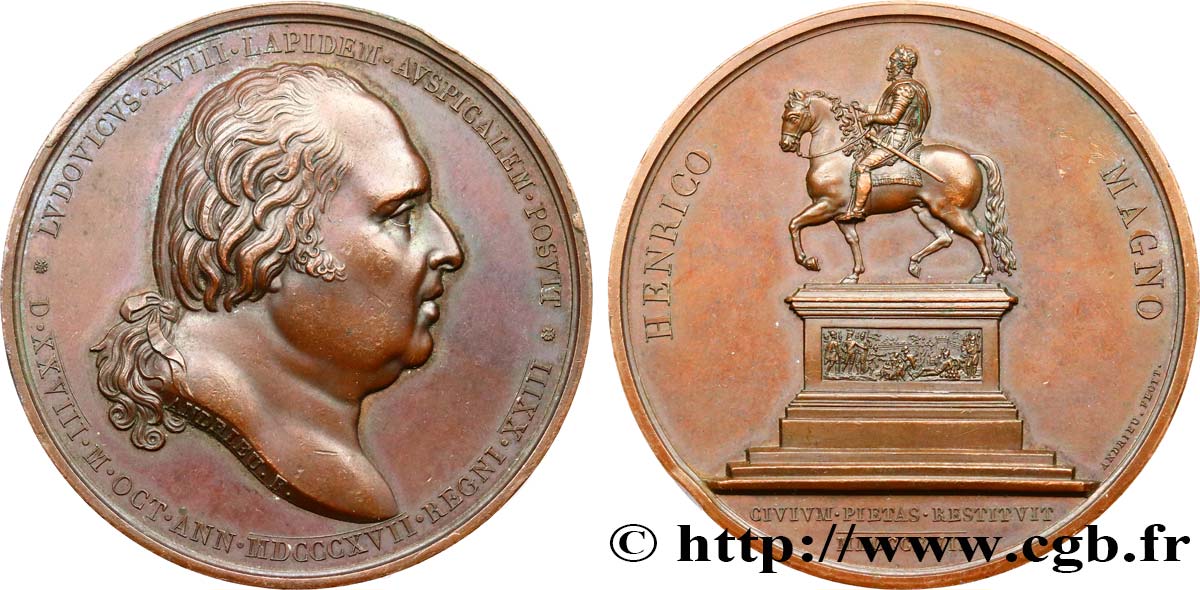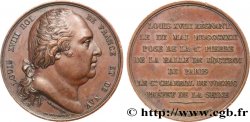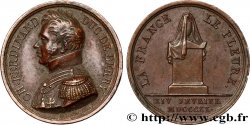Live auction - fme_685237 - LOUIS XVIII Médaille, Statue équestre d’Henri IV
Чтобы принять участие в торгах, вы должны войти в систему и стать подтвержденным участником аукциона. Войдите, чтобы сделать ставку. Ваш аккаунт будет подтвержден в течение 48 часов. Не ждите до закрытия торгов, чтобы зарегистрироваться.Сделав ставку на данный товар, вы вступаете в юридическое соглашение на покупку выбранного товара и нажатием кнопки «Сделать ставку» подтверждаете принятие вами условий интернет-аукционов cgb.fr.
Ставка может бить сделана только в полном эквиваленте евро. Торги закроются согласно времени, указанному в описании товара, все ставки, сделанные после закрытия торгов, учитываться не будут. Не следует откладывать предложение вашей ставки до последнего момента, так как система может не успеть обработать вашу заявку, и ваша ставка не будет принята. Более детальную информацию вы найдёте здесь: FAQ по интернет-аукционам.
Все ставки победителей подлежат комиссии 18%.
Все ставки победителей подлежат комиссии 18%.
| Оценить : | 85 € |
| Цена : | 35 € |
| Максимальная предлагаемая цена : | 61 € |
| Конец торгов : | 13 February 2024 16:30:17 |
| Участников : | 1 Участников |
Тип Médaille, Statue équestre d’Henri IV
Дата: 1817
Металл: copper
Диаметр: 49,5 mm
Ориентация осей монеты: 12 h.
Гравер ANDRIEU Jean-Bertrand (1761-1822)
Вес: 64,70 g.
Век: lisse
Пуансон: sans poinçon
Комментарии о состоянии
Patine marron hétérogène avec des traces de manipulation dans les champs. Présence de quelques coups et rayures, notamment sur la tranche
Ссылки в каталоге: :
Лицевая сторона
Аверс: легенда: * LVDOVICVS. XVIII. LAPIDEM. AVSPICALEM. POSVIT * - D. XXVIII. M. OCT. ANN. MDCCCXVII. REGNI. XXIII.
Аверс: описание: Buste nu à droite ; sur le col, signé : ANDRIEU F..
Обратная сторона
Реверс: легенда: HENRICO - MAGNO ; À L’EXERGUE : CIVIVM. PIETAS. RESTITVIT / MDCCCXVII.
Реверс: Описание: Dans le champ, statue équestre à gauche sur un piédestal timbré d’un bas-relief représentant le siège de Paris ; signé à droite : ANDRIEU. FECIT..
Комментарий
Par cette série de médailles, Louis XVIII affirme sa parenté avec le populaire Henri IV.
La première statue équestre d'Henri IV est exécutée par Giambologna et Pietro Tacca, elle fait partie de la composition de la place Dauphine et est inaugurée en 1614. Elle comportait à chacun des angles de son piédestal une statue d'esclave, de style maniériste, réalisée par Pierre de Francqueville. Cette première statue équestre est abattue en 1792 pendant la Révolution française pour faire des canons. Les statues des captifs se trouvent désormais au musée du Louvre.
La statue actuelle est l'œuvre du sculpteur François-Frédéric Lemot ; elle fut inaugurée le 25 août 1818. Lors de cette nouvelle érection, plusieurs objets furent placés à l'intérieur de la statue. Des documents en parchemin relatifs à l'inauguration de la statue, 26 médailles, 3 ouvrages sur Henri IV. L'ensemble était placé dans le ventre du cheval et se trouve aujourd'hui conservé dans l'Armoire de fer aux Archives nationales, Musée de l'histoire de France. Voici la liste des 18 pièces suivant les côtes des Archives nationales :
AE/I/15bis/1/1 à 6 - Boîte de plomb à âme de bois ayant contenu les parchemins relatifs à l'inauguration de la statue d'Henri IV au Pont-Neuf et les documents sur parchemin.
AE/I/15bis/2/1 à 2 - Boîte de plomb à âme de bois ayant contenu les Économies royales de Maximilien de Béthune, duc de Sully, 2 volumes in-folio reliés par Simier, relieur du roi, veau rouge et dorures, armes de France.
AE/I/15bis/3/1 à 2 - Boîte de plomb à âme de bois ayant contenu La Henriade de Voltaire, exemplaire sur vélin relié par René Simier, était en maroquin bleu, "avec dentelles, compartimens et armes de France". La reliure a disparu, soit par décomposition, soit par agglutination avec un des pans de la boîte en bois.
AE/I/15bis/4/1 à 3 - Boîte de plomb à âme de bois ayant contenu Histoire du roi Henri le Grand, par Hardouin de Péréfixe, Renouard, Paris, 1816, 1 volume in 8o relié par Simier, relieur du roi, en maroquin vert, avec dentelle et tranche dorée. Volume en très bon état de conservation, reliure de très belle exécution et 26 médailles (argent, bronze et platine).
AE/I/15bis/5/1 à 5 - 4 boîtes cylindriques (étain ou bois) et un rouleau de parchemin.
L'édifice est classé au titre des monuments historiques en 1921.
La première statue équestre d'Henri IV est exécutée par Giambologna et Pietro Tacca, elle fait partie de la composition de la place Dauphine et est inaugurée en 1614. Elle comportait à chacun des angles de son piédestal une statue d'esclave, de style maniériste, réalisée par Pierre de Francqueville. Cette première statue équestre est abattue en 1792 pendant la Révolution française pour faire des canons. Les statues des captifs se trouvent désormais au musée du Louvre.
La statue actuelle est l'œuvre du sculpteur François-Frédéric Lemot ; elle fut inaugurée le 25 août 1818. Lors de cette nouvelle érection, plusieurs objets furent placés à l'intérieur de la statue. Des documents en parchemin relatifs à l'inauguration de la statue, 26 médailles, 3 ouvrages sur Henri IV. L'ensemble était placé dans le ventre du cheval et se trouve aujourd'hui conservé dans l'Armoire de fer aux Archives nationales, Musée de l'histoire de France. Voici la liste des 18 pièces suivant les côtes des Archives nationales :
AE/I/15bis/1/1 à 6 - Boîte de plomb à âme de bois ayant contenu les parchemins relatifs à l'inauguration de la statue d'Henri IV au Pont-Neuf et les documents sur parchemin.
AE/I/15bis/2/1 à 2 - Boîte de plomb à âme de bois ayant contenu les Économies royales de Maximilien de Béthune, duc de Sully, 2 volumes in-folio reliés par Simier, relieur du roi, veau rouge et dorures, armes de France.
AE/I/15bis/3/1 à 2 - Boîte de plomb à âme de bois ayant contenu La Henriade de Voltaire, exemplaire sur vélin relié par René Simier, était en maroquin bleu, "avec dentelles, compartimens et armes de France". La reliure a disparu, soit par décomposition, soit par agglutination avec un des pans de la boîte en bois.
AE/I/15bis/4/1 à 3 - Boîte de plomb à âme de bois ayant contenu Histoire du roi Henri le Grand, par Hardouin de Péréfixe, Renouard, Paris, 1816, 1 volume in 8o relié par Simier, relieur du roi, en maroquin vert, avec dentelle et tranche dorée. Volume en très bon état de conservation, reliure de très belle exécution et 26 médailles (argent, bronze et platine).
AE/I/15bis/5/1 à 5 - 4 boîtes cylindriques (étain ou bois) et un rouleau de parchemin.
L'édifice est classé au titre des monuments historiques en 1921.








 Cообщить об ошибке
Cообщить об ошибке Распечатать страницу
Распечатать страницу Отправить мой выбор
Отправить мой выбор Задать вопрос
Задать вопрос Consign / sell
Consign / sell
 Информация
Информация










